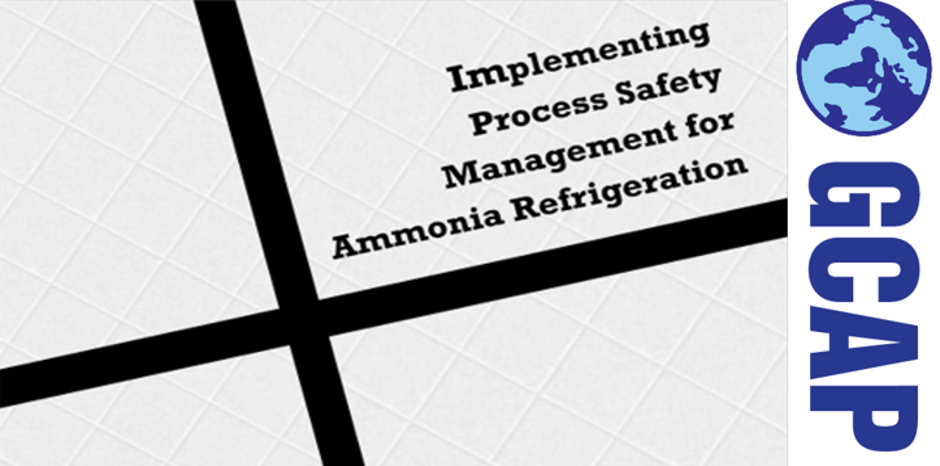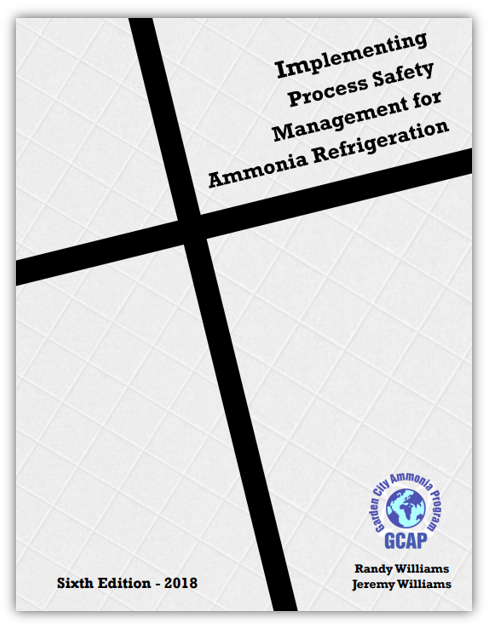“Implementing Process Safety Management for Ammonia Refrigeration Systems” 6th Edition
All of this material is covered or introduced to the student at our seminar. This selection of material will allow success in company’s regulatory requirements.
Process Safety Management
Risk Management Program
OSHA Compliance Book 29 CFR 1910.119
EPA Compliance Book 40 CFR 68
PSM/RMP
Introduction:
Too often in the Ammonia refrigeration industry the people tasked with creating and maintaining the Process Safety Management systems that cover our refrigeration systems are simply shown a collection of binders and told “Good Luck”. Most PSM practitioners we know have suffered this fate at least once in their careers and were nearly overwhelmed trying to make sense of reams of paperwork with little training and even few resources. GCAP set out to create a book as a guide that could be used as a basis of understanding for each new person “tossed to the wolves” in the PSM realm.
“Implementing Process Safety Management for Ammonia Refrigeration” was written for the exclusive use of Garden City Ammonia Program as a textbook for their Process Safety Management class and to outline a standard of educational material, guidelines, and best practices for the Ammonia industry. Throughout the years GCAP has met hundred of PSM practitioners and every one left at least one good idea to GCAP. In some sense, the text presented represents the collected wisdom of those hundreds of PSM practitioners operating thousands of facilities. GCAP’s focus is on real-world implementation; with due deference given to the practical needs of the facility, the requirements under the regulations and the challenges we face in an increasingly fast-paced and completive business world.
OSHA’s National Emphasis Program (NEP or CHEMNEP) has served to highlight the deficiencies in the way Process Safety Management for Ammonia refrigeration is currently implemented. The NEP draws from PSM experience in the chemical process and petroleum refinery sectors, so we have adopted some the ideas and approaches present in the excellent Center of Chemical Process Safety (CCPS) books. GCAP believes that the IIAR is the appropriate source for information regarding the proper design, installation, maintenance, and operation of mechanical Ammonia refrigeration systems; however GCAP turns to the CCPS and other organizations for guidance on how the Process Safety Management programs that cover these systems should be designed and implemented.
GCAP’s book represents the best professional efforts; it should be viewed only as a guideline to implementation; the PSM & RMP regulations, the letters of interpretation form the regulatory agencies and the legal system hold the final say when it comes to compliance. Process Safety Management Systems must continue to change to meet the challenges presented by evolving regulatory views and Recognized and Generally Accepted Good Engineering Practices (RAGAGEP). We at GCAP will continue to update our book as a standard reference for implementation of Process Safety Management for Ammonia Refrigeration.
We at GCAP thank you for investing your time in our Process Safety Management course. When you attend a GCAP course you are joining a family of over 20,000 Ammonia professionals throughout the world. Please always think of the GCAP team as a resource at your disposal when you have any questions about PSM implementation or any Industrial Refrigeration topic.
Your ability to effectively coordinate, your dedication, your talents, and your hard work will be the deciding factors in your PSM implementation. Process Safety Management is a “Team Sport” and while many teams have star players, everyone’s contribution is invaluable if the team is to reach their goals. The oft-repeated line “A bad system will beat a good employee every time” is absolutely true when it comes to PSM implementation. So remember the PSM system you implement in your facility must reflect both the unique needs of that facility and its personnel.
This book can be aquired by purchasing or taking the corresponding class!. More information at this link.



